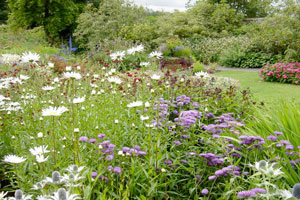Summer tasks in the garden
 In his latest column, Tom Attwood, of Abi and Tom’s Garden Plants, gives some advice on coping with the garden in full summer swing, composting and weeding.
In his latest column, Tom Attwood, of Abi and Tom’s Garden Plants, gives some advice on coping with the garden in full summer swing, composting and weeding.
The delayed start to the season this year has resulted in a tsunami of growth after what was a grindingly slow spring. Controlling this growth is a challenge but staking earlier in the season will help enormously. If you find, as I have, that certain plants no matter how hard you try have still collapsed (Papaver, Cephalaria, Cirsium and Lupin for example) due to unseasonal winds, then be ruthless, cut them back to remove any twisted or broken stems. Trying to re-engineer a collapsed plant is beyond the most skilled gardener. The new shoots produced after pruning will set the plants in good stead for the remainder of the season and into next year.
With growth rates in the garden in full swing there is a steady supply of annual weeds, pruned stems and grass cuttings. All of which have the potential to make the most fantastic compost mulch to use later in the year. We use 4 large bins, the aim is to keep turning the heaps as often as possible, the mixture needs to be layered, varied, chopped reasonably fine and interspersed with sheets of newspaper and cardboard which works incredibly well.
 A plastic sheet covering the entire heap will contain the heat generated and prevent the material from getting overly wet. Those I’ve started most recently are almost hot to the touch. The larger the heap the easier it is to achieve rapid composting. Try to be as generous with your proportions as possible when building or buying a set of bins.
A plastic sheet covering the entire heap will contain the heat generated and prevent the material from getting overly wet. Those I’ve started most recently are almost hot to the touch. The larger the heap the easier it is to achieve rapid composting. Try to be as generous with your proportions as possible when building or buying a set of bins.
The ornamental plants are not on their own when it comes to growing fast. Many of the perennial and annual weeds are having their moment. Some are much easier to deal with than others. We have to contend with the remnants of bind weed in our display borders. (Right, The garden at Wallington, Northumberland, in full summer bloom.)
It had a strangle hold on the site 5 years ago. It’s a tedious chore but physically digging them out is the only way to completely eliminate them, whilst combing this with the weakening effects of hoeing, smothering and the selective use of herbicides.
The leaves and stems of most perennial plants can be composted but not the roots, these are best to put into the green waste bin where it will be composted on an industrial scale.
Keep feeding containers and planters, especially those crammed with burgeoning bedding plants. A weekly feed using tomato food is more than adequate and will prolong flowering and develop larger more impressive plants for the remainder of the summer.
Happy gardening, Tom.
Abi and Tom’s Garden Plants, Halecat Nursery, Witherslack, Cumbria, stock a wide range of plants including heraceous perennials, shrubs and bedding plants. All herbaceous perennials and young shrubs are grown at the nursery. For more information log onto:
http://www.halecatplants.co.uk/
Photo credits: © Reckless Gardener

